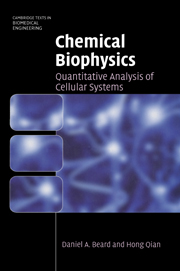Book contents
2 - Conventions and calculations for biochemical systems
Published online by Cambridge University Press: 05 June 2012
Summary
Overview
Biochemical species, from small-molecule metabolites such as inorganic phosphate to large proteins, reversibly bind hydrogen and metal ions, altering their thermo-chemical properties. Inorganic phosphate, for example, may exist in solution in several different states of protonation, including H2PO4− and HPO42−. Yet in the biochemical literature it is standard practice to refer to the concentration of inorganic phosphate without explicitly considering the different species that contribute to its overall concentration.
In this chapter we describe how to derive expressions for apparent equilibrium constants and apparent Gibbs free energies for biochemical reactions expressed in terms of reactants that are made up of sums of rapidly interconverting species. We will see that the calculation of free energies, pH, and other variables that change as reactions evolve depends on the constraints that are imposed on a reaction system – is the system closed, or is the system maintained in a non-equilibrium steady state by transporting material into and out of the system? Is pH held constant by injecting or removing hydrogen ions or does the pH vary as the reactant concentrations change? We will see that consideration of these questions will be important in developing simulations of both in vivo and in vitro biochemical systems.
Conventional notation in biochemical thermodynamics
In this book, we follow the convention that the term species refers to a unique chemical compound, while a reactant is a biochemical compound that may be present as a number of related and rapidly inter-converting species.
- Type
- Chapter
- Information
- Chemical BiophysicsQuantitative Analysis of Cellular Systems, pp. 24 - 40Publisher: Cambridge University PressPrint publication year: 2008
- 3
- Cited by



